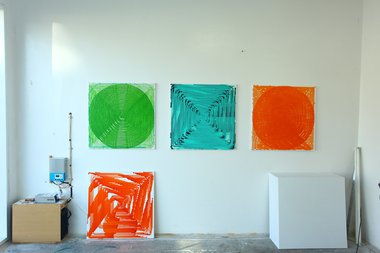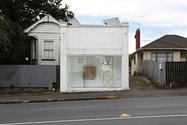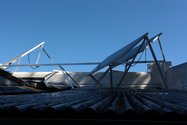John Hurrell – 25 May, 2014
With the daubing and dripping brush methodically dipping into the Legoheld paint pot, the marks are not pristine. They have a wild looseness that cumulatively eventually creates shimmering single-colour layers. Other strata of other colours, and other radiowave treatments, can be added on top - increasing the painted mark density and gradually blocking out slivers of the original white canvas.
Simon Ingram’s Radio Painting Station is the fourth long term exhibition program for Jar, the constantly open, street front art venue on New North Road in Morningside. With financial assistance from the Chartwell Trust, the gallery space has been modified to incorporate solar panels so that electricity can be generated by the sun and stored in a battery, so that his painting robot can function. An inverted pyramid aerial on a wooden stand has also been placed under the skylight to capture VLF (Very Low Frequency) radio emissions from outer space, and a plywood box structure to hold the worked on canvas and the artist’s cybernetic system screwed to the main wall. Ingram, well known for his Lego robot paintings and programmatic mark-making procedures, has been working with radio waves to make paintings for some years now, and Jar in its previous shows, had no electrical component at all.
Using stored data from radio wave signals as a means of positioning painted strokes, Ingram can manipulate the format of the information so that the canvas can be treated to present concentric squares or circles, winding spirals or more complex, vaguely swastika-like /whirling Catherine wheel configurations. With the daubing and dripping brush methodically dipping into the Legoheld paint pot, the marks are not pristine. They have a wild looseness that cumulatively eventually creates shimmering single-colour layers. There are sometimes little gaps between flowing lines, or (due to the angle of the brush) the horizontal tremulous lines are thinner than the vertical ones. Other strata of other colours, and other radiowave treatments, can be added on top - increasing the painted mark density and gradually blocking out slivers of the original white canvas.
The layering effect here reminds me of the work of James Cousins, and Ingram‘s method (with its now complex sandwiching) could be an affectionate tip of the hat to his friend. Yet Ingram’s practice basically is very different, being about the building up of discrete marks so they form a totality. They are holistic but they are also separate, alluding to piecemeal units of time - taking many small steps before a big step to another layer.
Because the machinery is fragile and Ingram’s exhibition unusually long, the robotic painting process is not continuous, only in bursts, performed at irregular intervals - determined at the artist’s discretion. This deliberate indication of the artist’s personal whims (and not fixed scheduling) is reflected in some of the very recent works (not photographed here) where underpainted layers have been gestural, made spontaneously by hand with a variety of brushes.
Due to ionization in the upper atmosphere from solar flares or lightning storms, the 3-30 kHz radio waves that Ingram collects and manipulates fluctuate in their amplification. That means he can either accentuate or downplay these vacillations (tiny vibrations) within his formal linear arrangements. However the graphic paintings he ends up with emphasise the relationship of the two layers together, one treatment of ‘time’ obscured by the other, such as say convulsive ‘zigzagging’ by rotating ‘cyclic’. Like a sort of duet, the first ‘voice’ calling from a time long ago gets accompanied by a pre-empting answer from the second, even while the first is still speaking and has only just started.
As the number of Ingram’s completed works increases they get hung on, or leant against, the lefthand wall, sharing the very public, Jar ‘studio’ with other materials such as waiting primed stretchers and containers of mixed colour. In these paintings we can see the artist form a strange partnership with selected natural forces from outer space, eliciting wobbly painted vectors that he can recompose via programmes and ‘stack’ across the picture plane. It is not a case of Sigmar Polke’s ‘Higher Beings Command’- for Ingram is far from passive. He listens and makes decisions: he never abdicates his Will - this being a dance where he leads. Never a puppet or rag doll.
John Hurrell
Recent Comments
John Hurrell
Here is a link to more info: http://www.wystancurnow.com/ingram/
John Hurrell
The latest array of paintings presented at Jar by Simon Ingram is worth checking out. These works seem to be ...








 Two Rooms presents a program of residencies and projects
Two Rooms presents a program of residencies and projects Advertising in this column
Advertising in this column



This Discussion has 2 comments.
Comment
John Hurrell, 5:37 p.m. 7 September, 2014 #
The latest array of paintings presented at Jar by Simon Ingram is worth checking out. These works seem to be a tip of the hat to Roy Lichtenstein or Neil Dawson, but dribbly, presenting ripples (like Dawson's sculpture outside Waikato museum - in the trees by the river) and alluding to radio wave transmission. Their lower curved black lines also allude to the cables looping up in parallel from the robotic machinery to the radio wave aerial inside the skylight.
John Hurrell, 9:42 a.m. 29 September, 2014 #
Here is a link to more info:
http://www.wystancurnow.com/ingram/
Participate
Register to Participate.
Sign in
Sign in to an existing account.